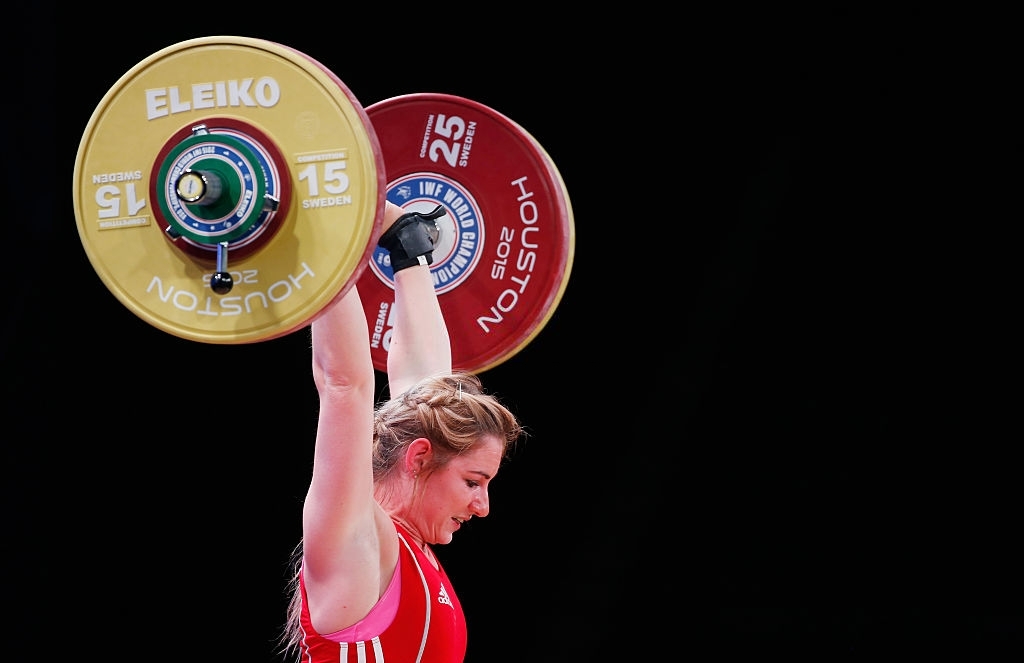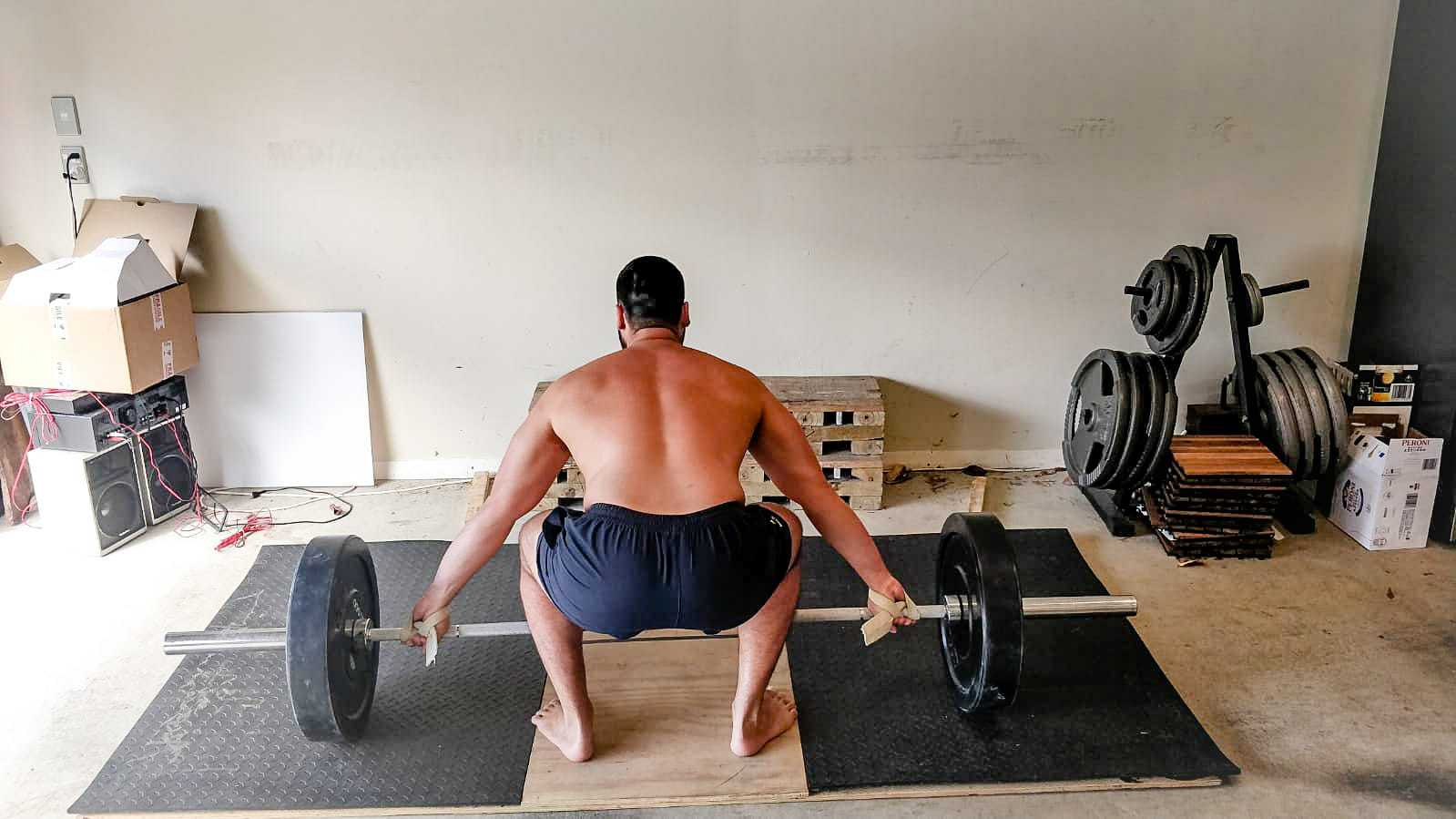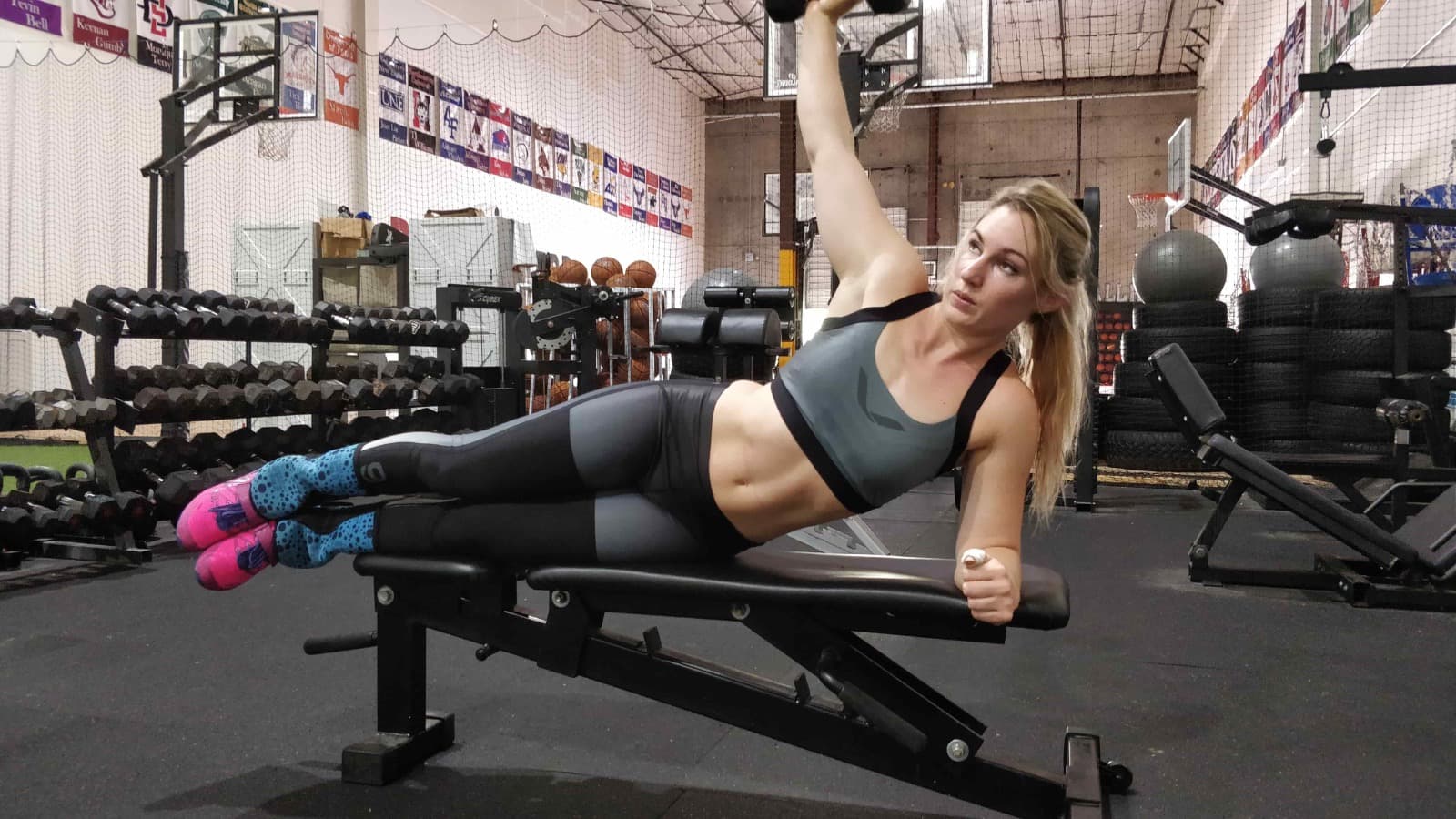Look at some of the elite Weightlifters and you will see some impressive physiques. Massive quads and backs are a hallmark of a high-level Weightlifter. Not always, but these muscular adaptations seem to be present more often than not. Is it the Olympic Weightlifting that builds muscle?
The Olympic lifts are not good for building muscle as they don’t maximize the mechanisms of hypertrophy. However, the high volume and frequency of pulls and squats and supplementary bodybuilding exercises create a strong muscle-building response.
It'd be naïve to ignore the fact that steroid use in elite-level Weightlifting is rampant and may enhance these muscular looks. There are also many Weightlifters that don't have slabs of muscle on them.
Is this a product of their training? Genetics? Let's dive into why the Olympic lifts aren't good for building muscle and how we can modify Olympic Weightlifting training routines to maximize the muscle-building response.
Table of Contents
What Is Olympic Weightlifting?

When I’m talking about Olympic Weightlifting in this article, I’m referring to the sport of Weightlifting and the type of training specifically to improve the total of the snatch and clean & jerk in competition.
The snatch (bar from the floor to overhead in one movement) and the clean & jerk (bar from the floor to overhead in two movements) are the two competition exercises in the sport of Weightlifting.
Weightlifters will perform different variations of these competition exercises such as power snatches and power cleans and also strength-based exercises such as squats and pulls from the floor to increase their total.
The most important thing to remember in regards to Olympic Weightlifting is the number one goal is to lift more weight in the two competition lifts. Not to build muscle. And not to isolate and target certain muscles with different movements.
Are Olympic Lifts Good For Building Muscle?

We’ve established that the goal of Weightlifting is to get stronger, not build muscle. However, is performing the Olympic lifts (snatch and clean & jerk exercises) good for building muscle?
The short answer is no.
The Olympics lifts themselves aren’t good for building muscle as they don’t maximally stimulate the main mechanisms of hypertrophy known as mechanical tension, metabolic stress, and muscle damage.
Here is a quick overview of each mechanism to help you gain a full understanding of muscle growth and how it pertains to the Olympic lifts.
Mechanical Tension
Mechanical tension is generated by force production and stretch of the muscle and is considered essential for muscle growth [1]. This means taking a muscle through a full range of motion under load is a potent combination for muscle building.
By taking a muscle through a full range of motion, it goes through three distinct phases of movement. Taking the squat as an example, there is a lowering phase (eccentric), an upwards phase (concentric), and a phase in between where no change in muscle length is seen (isometric).
The lowering phase or eccentric contraction of the muscle seems to produce the greatest muscle-building response that is preferentially seen in the fast-twitch muscle fibers [1].
However, mechanical tension isn't solely responsible for muscle growth which has been shown in a study where heavier eccentric training (low metabolic stress, high mechanical tension) did not produce greater hypertrophy than concentric training (high metabolic stress, lower mechanical tension) [2].
Metabolic Stress
Metabolic stress is caused by a build-up of by-products in the muscle from energy production. Specifically, from the anaerobic lactic energy system [1]. Which, in a very simplistic explanation, lasts up to 90-120 seconds during very intense exercise.
These by-products from the anaerobic lactic energy production such as lactate and hydrogen ions signal a muscle growth response.
Metabolic stress can be heightened by the use of creating a further hypoxic (oxygen-deprived) environment through the use of blood flow restriction or simulated altitude.
While metabolic stress isn't an essential component of muscle growth, it seems to have a very large effect on hypertrophy.
Anecdotally, this can be seen in typical bodybuilding programs where moderate-intensity training is used to find a middle ground between maximizing metabolic stress while maintaining mechanical tension.
Muscle Damage
Muscle damage is the final piece of the muscle growth mechanistic puzzle which is a by-product of both mechanical tension and metabolic stress. Muscle damage is an acute inflammatory response that triggers the body's natural response to repair the damaged muscle [1].
This is why anti-inflammatory drugs are not recommended during muscle gain cycles as it blunts the inflammatory response.
However, while muscle damage may play a role in muscle growth, there has yet to be a direct cause and effect relationship between exercise-induced muscle damage and muscle growth [3].
So where do the Olympic lifts fit into these mechanisms of muscle growth? Mechanical tension is not maximized as the snatch and clean are mainly concentric-only movements for the lower body with the upper body acting isometrically.
During the jerk, there is a triphasic movement (eccentric, isometric, and concentric) that occurs during the dip and drive but the range of motion is too small to induce a large enough stretch to the muscle to maximize tension.
Metabolic stress is virtually non-existent during the snatch and clean & jerk. For two main reasons:
Muscle damage does occur during the snatch and clean & jerk but not to the same extent as a regular strength training exercise as there is little eccentric contraction which causes the greatest muscle damage.
While these mechanisms serve the foundation of muscle building, there are still more training variables that contribute to building muscle. There is a reason Olympic Weightlifters have some of the largest legs and backs.
Volume
Volume is defined as the number of sets, reps, and loads used in a training session [1]. For the sake of muscle growth, volume load is often used which is calculated as the total number of repetitions multiplied by the load lifted [4].
10+ sets per week, per muscle group seems to maximize muscle growth. This can go all the way up to around 20 sets per week per muscle group. Upwards of 30 sets per week per muscle group have been shown to be sub-optimal compared to 20 sets per week per muscle group in regards to muscle growth [5].
It should also be noted that a low volume approach (<4 sets per muscle group per week) can also stimulate muscle growth just not to the same degree as a higher volume approach.
It is unclear whether this is a product of mechanical tension, metabolic stress, muscle damage, or a combination of all of these. Some research has pointed to the acute increase in anabolic hormones such as testosterone and growth hormone [6].
However, the relationship between acute hormonal spikes within physiological range and muscle growth is dubious at best [7].
Intensity

Intensity, or load, is said to have the most influence and is arguably the most important programming variable to muscle growth [1].
Loading can be thought of in three different rep ranges:
- 1-5 rep range known as the “strength” range between 80-100% 1RM.
- 6-12 rep range known as the “hypertrophy” range between 60-80% 1RM.
- 15+ rep range known as the “endurance” range <60% 1RM.
The moderate “hypertrophy” rep range has been thought to maximize muscle gain. However, recent research has proven this to be incorrect where no differences were found in muscle growth when comparing high loads (>60% 1RM) to low loads (<60% 1RM) [8].
When looking at research that equates volume load (sets x reps x load), low and moderately loaded protocols showed similar changes in muscle mass after 6 weeks [9].
High and moderate loading also showed similar results in muscle growth where 3 x 10RM vs 7 x 3RM showed similar increases in bicep size [10].
However, the high load group started to show signs of over-training and joint pain by the end of the study indicating heavy loading protocols are very taxing when trying to maximize volume and may be unsustainable.
Regarding the minimum intensity that can be used to incur muscle growth, the threshold seems to be as low as 30% 1RM [11].
Overall, it seems a mix of high, moderate, and low load exercise is the best way to maximize the muscle growth response rather than staying in the “hypertrophy” zone.
Frequency
It is common thinking that training more will result in greater muscle growth. Further, as there is a dose-response relationship between volume and muscle growth, if you can train more often, you can get more volume per body part.
It has been found that training muscle groups two times per week is superior to one time per week [12]. This is likely because getting 10+ sets for a muscle group in one session will cause a reduction in intensity throughout the session due to fatigue.
FIGHT MAINSTREAM FITNESS & MAKE ASTRONOMICAL GAINS
If training is split over two days, intensity can remain higher resulting in higher quality training sessions.
It should be noted that there is no evidence to suggest that taking a current high-volume approach and splitting it over more days will increase the muscle growth response so frequency for frequencies sake may not be beneficial.
What Olympic Weightlifting does well is the high volumes, varying intensities, and high frequencies of training of the main competition exercises in training. Could this be the key to building muscle with the Olympic lifts?
How To Use The Olympic Lifts To Build Muscle
While the Olympics lifts don’t tick the mechanistic boxes for muscle growth, they tick all of the boxes for exercise programming variables.
Unfortunately, this is not enough for the snatch and clean & jerk to be great muscle builders. However, Olympic Weightlifting training programs can be used and manipulated to build muscle.
This means a greater emphasis is placed on pulls and squats over the snatch and clean variations.
Further, many elite Olympic Weightlifters perform bodybuilding style training as part of their preparation to develop key musculature needed when lifting heavy loads overhead and as a way to keep their joints healthy.
In fact, in the olden days of physical culture, many champion Olympic Weightlifters were also champion bodybuilders. Think of legends like Tommy Kono and John Grimek.
When using Olympic Weightlifting to build muscle, here is how you would break down each movement for each part of the body:
Quads | Hamstrings & Glutes | Back & Traps | Shoulders & Triceps |
|---|---|---|---|
Front Squats | Clean Pulls/Deadlifts | Clean Pulls/Deadlifts | Press |
Back Squats | Snatch Pulls/Deadlifts | Snatch Pulls/Deadlifts | Push Press |
Cell | Floating Pulls/Deadlifts | Floating Deadlifts | Behind The Neck Push Press |
Cell | Romanian Deadlifts | Romanian Deadlifts | Snatch Grip Press |
Cell | Cell | Power Cleans | Cell |
Cell | Cell | Power Snatches | Cell |
Cell | Cell | Clean & Snatch High Pulls | Cell |
Many of the greatest physiques in the old-time strongman era were built without the bench press or a heavy reliance on chest exercises. Large, dense upper backs, erector spinae, and shoulders were what created their power look.
If you’re interested in this, look to the likes of Eugene Sandow and George Hackenschmidt.
Olympic Lifting Hypertrophy Routine
Here is how you can set up a 4-day a week Olympic lifting hypertrophy routine with the goal of building dense legs, back, and shoulders.
Day 1 (Quads & Shoulders)
Exercise | Set/Rep | Intensity |
|---|---|---|
A1) Push Press | 4 x 5 | 75-80% 1RM |
B1) Front Squat | Heavy Double then 4 x 5-6 | Double @88-93% 1RM (8-9 RPE). Back offs @70% 1RM |
C1) Press | 3 x 8-12 | 7-8 RPE |
Day 2 (Back, Glute/Hams)
Exercise | Set/Rep | Intensity |
|---|---|---|
A1) Power Snatch | Heavy Triple | 3RM |
B1) Snatch High Pull | 3 x 3 | 5-10 kg over max triple for the day |
C1) Power Clean | Heavy Triple | 3RM |
D1) Clean High Pull | 3 x 3 | 5-10 kg over max triple for the day |
Day 3 (Quads, Shoulders)
Exercise | Set/Rep | Intensity |
|---|---|---|
A1) Back Squat | Heavy Triple then 4 x 6-8 | Triple @83-88% 1RM (8-9 RPE). Back offs @60-70% 1RM |
B1) Snatch Grip Press | 4 x 8-12 | 7-8 RPE |
C1) Bent Over Reverse Fly | 3 x 15-20 | 7-8 RPE |
Day 4 (Back, Glutes/Hams, Shoulders)
Exercise | Set/Rep | Intensity |
|---|---|---|
A1) Snatch High Pull Blocks Above Knee | 4 x 4 | 7-8 RPE |
B1) Behind The Neck Push Press | 4 x 5 | 7-8 RPE |
C1) Floating Clean Pull | 3 x 5 | 7-8 RPE |
It's important to note a program based around Olympic Weightlifting variations for hypertrophy is highly taxing. Because every movement is essentially a full-body movement.
This creates systemic fatigue much greater than performing isolated bodybuilding movements.
Further, we are trying to make up the volume load at heavier loading schemes contributing even further to fatigue.
Knowing this will ensure you don’t run a program like this for months on end and that you don’t perform a program like this on a diet.
Another cool hypertrophy variation is something I’ve tried from South African Weightlifting coach Pieter Pretorius. If you like to deadlift, and you want to build a massive back, then this is something you can try.
Exercise | Set/Rep | Intensity |
|---|---|---|
A1) Snatch Grip Deadlift | 1 x 15, 1 x 12, 3 x 10, 1 x 8 | 7-8 RPE. Increase load each time reps decrease. |
I made 2.5 kg (5 lb) jumps between each set when reps were reduced.
Stuck In A Rut?
The LBEB Underground serves to support you with your strength and performance training by industry leading experts.
References
1. Schoenfeld, B. J. (2010). The mechanisms of muscle hypertrophy and their application to resistance training. The Journal of Strength & Conditioning Research, 24(10), 2857-2872.
2. Jones, D. A., & Rutherford, O. M. (1987). Human muscle strength training: the effects of three different regimens and the nature of the resultant changes. The Journal of physiology, 391(1), 1-11.
3. Schoenfeld, B. J. (2012). Does exercise-induced muscle damage play a role in skeletal muscle hypertrophy?. The Journal of Strength & Conditioning Research, 26(5), 1441-1453.
4. Schoenfeld, B., & Grgic, J. (2018). Evidence-based guidelines for resistance training volume to maximize muscle hypertrophy. Strength & Conditioning Journal, 40(4), 107-112.
5. Amirthalingam, T., Mavros, Y., Wilson, G. C., Clarke, J. L., Mitchell, L., & Hackett, D. A. (2017). Effects of a modified German volume training program on muscular hypertrophy and strength. The Journal of Strength & Conditioning Research, 31(11), 3109-3119.
6. Kraemer, W. J., Gordon, S. E., Fleck, S. J., Marchitelli, L. J., Mello, R., Dziados, J. E., ... & Fry, A. C. (1991). Endogenous anabolic hormonal and growth factor responses to heavy resistance exercise in males and females. International journal of sports medicine, 12(02), 228-235.
7. Schoenfeld, B. J. (2013). Postexercise hypertrophic adaptations: a reexamination of the hormone hypothesis and its applicability to resistance training program design. The Journal of Strength & Conditioning Research, 27(6), 1720-1730.
8. Schoenfeld, B. J., Grgic, J., Ogborn, D., & Krieger, J. W. (2017). Strength and hypertrophy adaptations between low-vs. high-load resistance training: a systematic review and meta-analysis. The Journal of Strength & Conditioning Research, 31(12), 3508-3523.
9. Lopes, C. R., Aoki, M. S., Crisp, A. H., de Mattos, R. S., Lins, M. A., da Mota, G. R., ... & Marchetti, P. H. (2017). The effect of different resistance training load schemes on strength and body composition in trained men. Journal of human kinetics, 58(1), 177-186.
10. Schoenfeld, B. J., Ratamess, N. A., Peterson, M. D., Contreras, B., Sonmez, G. T., & Alvar, B. A. (2014). Effects of different volume-equated resistance training loading strategies on muscular adaptations in well-trained men. The Journal of Strength & Conditioning Research, 28(10), 2909-2918.
11. Schoenfeld, B. J., Grgic, J., Van Every, D. W., & Plotkin, D. L. (2021). Loading Recommendations for Muscle Strength, Hypertrophy, and Local Endurance: A Re-Examination of the Repetition Continuum. Sports, 9(2), 32.
12. Schoenfeld, B. J., Ogborn, D., & Krieger, J. W. (2016). Effects of resistance training frequency on measures of muscle hypertrophy: a systematic review and meta-analysis. Sports Medicine, 46(11), 1689-1697.

 (@powerfulpretorius)
(@powerfulpretorius)